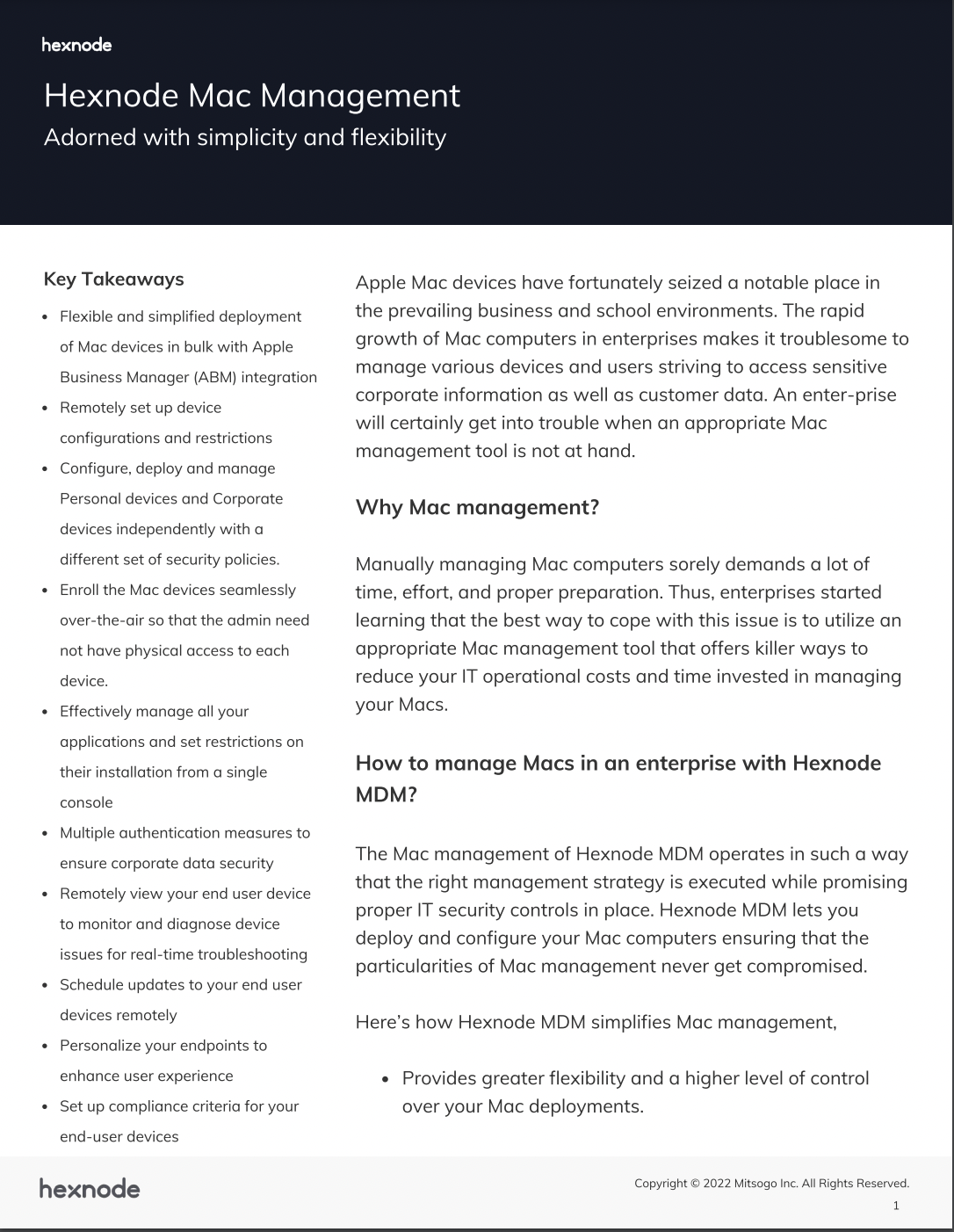Device security is a growing concern for individuals and organizations because the shadow of digital security threats looms ever larger. Although Mac devices are well known for their security measures, we are currently in an era where malware lurks around every virtual corner, leaving no room for complacency.
Imagine this scenario: Malware lurking patiently, waiting for the ideal moment to launch an attack on your Mac. This threat isn’t going away anytime soon; in fact, it’s likely to become even more widespread in the future. Even the much-heralded M1 Macs, introduced in November 2020, weren’t immune, falling prey to the Silver Sparrow malware that targeted both M1 Macs and their Intel-powered counterparts.
In this scenario, where threats loom and evolve, organizations need more than just a passive defense. They require advanced security tools to fortify their macOS device management. So, without further delay, let’s check out the essential Mac security tools that will empower you to expertly safeguard and manage your macOS device fleet. Buckle up, because in this digital age, securing your Macs is not just an option; it’s a necessity.
- Essential Mac security tools for macOS
- 6. Apple Business Essentials:
- 5. Patch and update management software:
- 4. Data Loss Prevention (DLP):
- 3. Endpoint detection and response:
- 2. Remote device health monitoring
- 1. Unified Endpoint Management (UEM) solutions:
- Tips and best practices for seamless software service implementation
- Conclusion
Essential Mac security tools for macOS
The security tools designed for macOS device fleet management offer a comprehensive solution that guarantees safety, and improves the user experience, all the while streamlining the management process. Here are six essential Mac security tools to effectively manage your macOS device fleet in an organization:
6. Apple Business Essentials:
Apple Business Essentials is Apple’s own suite of management tools designed to simplify device deployment, configuration, and security. These tools are designed to simplify the entire process for businesses.
Apple Business Manager is a specific platform within the Apple Business Essentials suite. It serves as a central hub for organizations to manage their macOS devices, apps, and content seamlessly.
The importance of using Apple Business Manager in your organization includes:
- Efficient deployment: Simplifies device setup, reducing manual configuration time.
- Streamlined app distribution: Distributes apps to multiple devices simultaneously, eliminating individual installations.
- Centralized configuration: Manages device settings from a single dashboard, ensuring consistency and security.
- Enhanced security: Enforces policies, encryption settings, and compliance monitoring for robust security.
- Remote management: Facilitates troubleshooting and management from a distance.
- User experience: Maintains standardized settings for a consistent user experience.
5. Patch and update management software:
Patch and update management software effortlessly manages the deployment of software updates and patches, ensuring that every device remains fortified with the latest security enhancements and performance optimizations. By automating this process, these software solutions reduce the complexities of manual updates, enhancing both security and functionality across the entire macOS fleet.
The key significance of using patch and update management software are as follows:
- Security enhancement: Ensures devices are up-to-date with the latest patches, reducing vulnerabilities.
- Automation: Automates patch deployment, minimizing manual effort and errors.
- Risk mitigation: Addresses software vulnerabilities swiftly, reducing the risk of cyber threats.
- Consistent performance: Maintains devices at optimal performance levels with updated software.
4. Data Loss Prevention (DLP):
Data Loss Prevention (DLP) helps to prevent unauthorized leakage or accidental exposure of important data. These tools are essential in maintaining data privacy and compliance with regulations. DLP software comes with a set of features that are aimed at securing data across different points, such as when it’s being used, stored, or transferred.
The key importance of using Data Loss Prevention tools includes:
- Security: Safeguards sensitive information against leaks and breaches.
- Regulatory compliance: Helps organizations adhere to data protection regulations.
- Trust building: Demonstrates commitment to data privacy, earning trust from customers and partners.
- Risk reduction: Minimizes the likelihood of data loss incidents that can harm the organization’s reputation.
- Business continuity: Ensures that critical data remains intact, supporting smooth business operations.
3. Endpoint detection and response:
Endpoint detection and response (EDR) software stands as a critical defense layer shielding macOS devices from hidden dangers. It excels in real-time scanning and swiftly detecting potential threats.
The key significance of using endpoint detection and response are as follows:
- Malware protection: Guards against malware, viruses, and other malicious threats.
- Real-time monitoring: Provides continuous monitoring for instant threat detection and response.
- Data protection: Safeguards sensitive data from unauthorized access or breaches.
- Regular scans: Conducts regular scans to identify and eliminate potential threats.
- Threat hunting: Allows security teams to proactively search for signs of compromise. This proactive approach helps identify and neutralize threats before they cause substantial damage.
- Threat intelligence integration: Integrate threat intelligence feeds, keeping organizations informed about the latest threats and vulnerabilities. This integration allows security teams to stay ahead of cybercriminals and adapt their defenses accordingly.
- Scalability: Accommodates organizations of varying sizes and device fleets. Whether managing a small number of macOS devices or a large enterprise fleet, EDR remains effective.
2. Remote device health monitoring
Remote device health monitoring software services provide IT teams with the power to overcome physical boundaries and offer remote assistance, transforming the troubleshooting landscape. Encompassing a spectrum of functionalities, including real-time diagnostics, these tools provide a lifeline for seamless issue resolution. By offering features like screen sharing, remote control, and diagnostics, they bring forth an efficient toolkit for addressing challenges.
The key significance of using remote device health monitoring tools are as follows:
- Remote assistance: Enables IT teams to diagnose and resolve issues on devices from a distance.
- Minimized downtime: Rapid problem resolution reduces device downtime and productivity loss.
- Cost efficiency: Reduces the need for on-site visits, saving time and resources.
- User satisfaction: Swift troubleshooting improves user experience and satisfaction.
1. Unified Endpoint Management (UEM) solutions:
Unified Endpoint Management (UEM) solutions provide advanced management capabilities to organizations, making it easy to handle all functions smoothly. One significant advantage of UEM solutions lies in their ability to enable remote device configuration, marking a shift from traditional management methods. Through UEM solutions, IT teams exercise the power to configure devices remotely, transforming the setup process. Moreover, these solutions go beyond the usual by enabling effortless application deployment and robust security enforcement.
Get started with Hexnode’s Mac Management solution to save your time and the associated IT operational costs of managing your Mac devices.

Featured resource
Hexnode Mac Management
The key significance of using UEM solutions are as follows:
- Centralized control: Provides a single platform to manage various device types and platforms.
- Policy enforcement: Enables consistent security policies across devices, enhancing data protection.
- Remote management: Allows remote configuration, troubleshooting, and updates for efficient management.
- Asset tracking: Tracks device inventory, usage, and compliance for informed decision-making.
- Efficient updates: Ensures timely software updates for all managed devices.
- Cost savings: Optimizes device management, reducing operational costs.
Conclusion
As we wrap up this journey through the realm of macOS device fleet management, one thing becomes abundantly clear: the landscape of efficient device management is evolving, and the tools at our disposal are more powerful than ever. These essential Mac security tools collectively form a robust foundation for managing your macOS device fleet effectively, ensuring optimal performance, security, and user satisfaction within your organization. Now, armed with the knowledge of essential Mac security tools, equip and lead your organization towards a more seamless, secure, and scalable future. Happy device management folks!
Start your 14-day free trial today!
Take the first step towards securing your digital environment with the power of Hexnode.
SIGN UP





